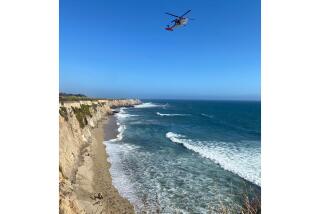A Tale of Luck, Pluck and the Deep Blue Sea
- Share via
SYDNEY, Australia — No one can hear you scream in the middle of the Pacific Ocean, clinging to a life jacket, trying to kick your tired body over the next big wave and telling yourself that help is just beyond the horizon.
A man caught in the swirl of the sea has to rely on mental as well as physical tenacity just to stay afloat.
But the mighty Pacific was kind to pilot Ray Clamback, who was hoisted to safety Tuesday after spending 17 hours flailing about in 4-foot-high waves, a tiny speck caught in Earth’s largest ocean after ditching his plane when the engine cut out 600 miles south of Hawaii.
For many fliers, the Pacific holds a certain mystique, one immortalized when Amelia Earhart went down somewhere in 1937 in circumstances that aviation historians have never stopped questioning.
“You feel vulnerable,” said Bill Finlen, an Australian who flew around the world solo in 2002. “It’s one of the loneliest places in the world.”
Clamback, 67, was beginning a 15-hour flight ferrying the plane from Hawaii to his native Australia when his aircraft went down. He had barely enough time to pull himself and his life jacket out of his single-engine Cessna 182 before it sank, taking with it his life raft and leaving him alone in open water.
“I hit a wave that was just a little high for me as I touched down,” a scarlet-cheeked Clamback told Australian Broadcasting Corp. radio after being rescued.
“The airplane turned upside down.... I could barely get out of it myself.”
Clamback was lucky, though: He wasn’t alone. A partner piloting another Cessna alongside him, circled the debris for 3 1/2 hours to relay the coordinates of Clamback’s position to the U.S. Coast Guard.
“A person in the ocean is very, very small,” said Chief Petty Officer Marsha Delaney, who dispatched a team to scour the sea for Clamback.
They found him seven hours later, still treading water, his neck rubbed raw from his life jacket and his face peeling from sunburn.
A C-130 Hercules dropped a life raft to him, and he clung to it for nearly 10 hours until he was picked up by the P&O; Nedlloyd container ship Los Angeles, sailing from the United States to Melbourne.
“We asked him if he was wounded. He said he was not injured, only a little bit exhausted, so we used a safety harness to winch him aboard,” the ship’s captain, Hans Wijntjes, told Sky News Australia.
His wet gray socks poking out from blue overalls, Clamback told reporters that he may give up trans-Pacific flights because of the ordeal -- it’s the second time this has happened to him. In 1999, he and a co-pilot ditched an airplane 230 miles east of Hawaii on a flight to Australia.
“I’ve been doing it for 30-odd years and it’s probably time I gave it away anyhow,” he said. “I certainly was weak when I got on board this vessel here. I could hardly stand up.”
Clamback has made the crossing 220 times, ferrying planes across the ocean. Those who know him don’t doubt his abilities, but agree that he might want to stop.
“I think it’s not a bad idea to give it up,” said Gaby Kennard, 60, who in 1989 emulated her hero, Earhart, and became the first Australian woman to make the solo round-the-world trip.
No one flies over the Pacific Ocean without a sense of trepidation, she said -- especially given the risks of crashing in a place where the chance of rescue is always in doubt.
“To be in the water would have been just hideous, and you think of sharks and that sort of stuff,” she said. “You see plenty when you’re in the air, so it’s not pleasant.”
Richard Hutch, a University of Queensland scholar who is working on a book called “Down to the Sea in Ships: Formative Personal Experiences of Men at Sea,” said Clamback was particularly lucky.
All the elements were in his favor -- winds were a gentle 11 mph and the temperature a tropical 75 degrees.
But more important, Hutch said, were two disparate but related things: Clamback’s resolve was strong and the sharks stayed away.
“If he’d freaked out, the sharks would have come because he would have sounded like an animal in distress, weak and available for tea,” Hutch said. “So perhaps he used his head; it was the second time he went down, so at least he was experienced in such a situation and he perhaps found a spiritual attitude to survive.”
More to Read
Sign up for Essential California
The most important California stories and recommendations in your inbox every morning.
You may occasionally receive promotional content from the Los Angeles Times.










